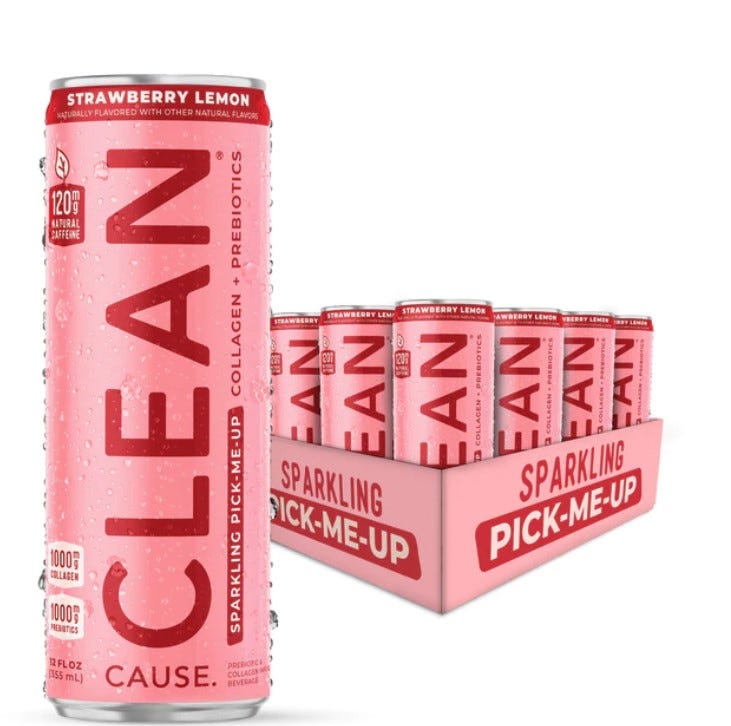
“Clean energy” is an emerging trend in the beverage industry that utilizes natural, plant-based sources of caffeine to support energy. Clean Cause’s initial play into this trend utilized yerba mate as a source of energy. (Yerba Mate is a South American plant that is similar in caffeine and antioxidant profile as tea.) Their newest line of beverages--Sparkling Pick-Me-Up with Prebiotics and Collagen--continues to play into this trend by including caffeine from green tea as well as some other “trendy” functional ingredients. Available in three different flavors—Strawberry Lemon, Berry Vanilla, and Orange Passion, we will be examining the Strawberry Lemon here for simplicity.
Purified Sparkling Water—Self explanatory
Organic Cane Sugar—Less processed than table sugar, organic cane sugar is able to retain some of the vitamins, minerals, and antioxidants from sugar cane. However, the amounts of these are not significant and, nutritionally, organic cane sugar is the same as regular table sugar.
Organic Erythritol—Naturally present in small quantities in some fruits and vegetables, commercial erythritol is made from corn using fermentation and enzymes. For some, it causes digestive issues if consumed in large quantities. Recently, studies have shown that it might increase the risk of heart attack and stroke.
Chicory Root Inulin (Prebiotic)—Chicory root is a plant that belongs to the dandelion family and naturally contains a large amount of inulin. Inulin is a prebiotic that supports the growth of good bacteria in the gut and can also aid in weight loss and blood sugar control.
Bovine Collagen Peptides—Collagen is the building block of skin, nails, and hair. As we age, our natural collagen production slows down resulting in sagging skin, thinning hair, and brittle nails. This type of collagen comes from the skin and bones of cows.
Organic Strawberry flavor—95% of an organic strawberry flavor comes from flavor chemicals that are derived from an organic strawberry and other organic sources. The remaining 5% of the flavor is flavor chemicals from strawberries or other fruit, vegetable, spice, or plant sources.
Organic Lemon flavor—See explanation above for the organic strawberry flavor.
Citric Acid—Naturally present in citrus fruits, citric acid creates the sour taste in citrus fruits. Commercially, it is produced as a fermentation by-product from mold.
Organic Lemon Extract—Organic lemons are soaked in alcohol and the flavor chemicals are extracted and concentrated to form an extract.
Organic Green Tea Extract—The caffeine naturally present in green tea is extracted and standardized to make a claim of 120 milligrams of caffeine.
Black Carrot (for coloring)—Black carrot is an intense purple color, due to its high antioxidant content. The antioxidants/color is extracted and concentrated to be used as a natural color. Note that any natural color is not a rich source of antioxidants.
Organic Stevia Extract—The sweet components of an organically grown stevia plant are extracted and concentrated.
Final Evaluation
Ingredient Quality: A-. There are no claims for this beverage, but the majority of the ingredients are organic.
Ingredient Clarity: A. All ingredients are purposely added and make sense to the overall product.
Functional Benefit: C+. This beverage addresses three trends—Gut Health, “Beauty from Within”, and Clean Energy. For gut health, Chicory Root Inulin is added as a prebiotic source. However, this beverage only contains 1 gram of fiber, not enough to appear as a significant daily value of fiber on the Nutrition Facts Panel. For “Beauty From Within”, collagen is added because it has been studied to improve hair, skin, and nail health. However, the effective dosage of collagen is between 2.5-5 grams per day. This beverage has 1 gram of collagen per serving, which is less than half of the minimum studied dosage. Finally, for Clean Energy, this beverage contains 120 milligrams of caffeine from green tea extract. The website claims that the caffeine is “jitterless”. However, this claim is confusing. Caffeine at any level can cause “jitters” to some. Compared to other energy drinks, the caffeine content here is lower, which might be the reasoning behind that “jitterless” claim. The only studied “jitterless” caffeine claims involve a combination of caffeine and l-theanine. Although green tea contains the highest amount of l-theanine in teas, it is doubtful that a green tea extract that is standardized for caffeine will contain any beneficial l-theanine.
Nutritional Value: B+. This product is 30 calories, which is much lower than sugar-laden sodas. However, it does contain 6 grams of added sugar, which is higher than a typical sparkling water.
Overall Score: B-. At initial glance, this product fits most of the major beverage trends—Gut Health, “Beauty from Within”, and Clean Energy. However, the dosages of the functional ingredients that represent these trends are not effective. Inulin is a well-known source of dietary fiber and a prebiotic that supports gut health. However, this beverage claims 1 gram of inulin, which is not enough to even show up on the nutrition facts panel as any significant source of dietary fiber. Collagen is “Beauty from Within”’s signature ingredient and has been well studied for hair, skin, and nail health. However, the minimum effective dosage is 2.5 grams per day. This beverage claims 1 gram; less than half of the minimum effective dosage. The true benefit of this product is as a low dosage energy beverage. Claiming 120 milligrams of caffeine (equivalent to a strong cup of coffee) is much lower than many other energy beverages, which is certainly appealing and differentiating. This beverage does contain cane sugar and erythritol (a now controversial sweetener) as the second and third ingredients, respectively; which does not exactly signal a healthy beverage. At $3/can, this is in the mid-price range of most functional sodas. However, with the lack of effective dosages of the functional ingredients, it’s hard to rationalize the purchase of this beverage.
Would you buy this product? Why or why not?



